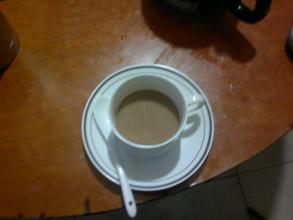Sour balanced Brazilian coffee beans Features and stories Three grades of Brazilian coffee beans
Harvest year: 2012-the year is for roasters' reference, so the year is usually not marked on the label of roasted ripe beans on the market.
In the coffee beans sold in the market, in order to reduce the trouble and identification burden of consumers, they generally do not make such complicated labels. There may be great differences in the flavor of coffee beans in different small producing areas and different years. Professional roasters will taste the raw coffee beans of the same year in different producing areas every year, and adjust the way of roasting and blending, so that consumers can get coffee with stable flavor and slight difference.
However, although the coffee taste indication described above is a common practice of coffee roasters, because the domestic coffee market is in its infancy, consumers can not taste the differences in various beans, so the coffee beans sold on the market are mixed. There is often a phenomenon of inferior quality, so when consumers buy high-level coffee beans, they still need to keep their eyes open and carefully identify trustworthy businesses.
Grade 1:Strictly Soft (very mild)
Grade 2:Soft (mild)
Grade 3:Softish (slightly mild)
Level 4:Hard (difficult)
Grade 5:Rio (light iodine flavor)
Grade 6:Rioy (strong iodine flavor)
Grades 1 to 3 are collectively referred to as "mild", with a balance of sweetness, bitterness and sour taste, and are good coffee with a warm and mellow taste. On the contrary, grades 5 and 6 are inferior products with iodine odor. The soil around Rio de Janeiro in Brazil has a strong smell of iodine, and when the coffee fruit falls on the soil, it will be stained with a unique flavor.
As we mentioned in the last issue, the best grade of Brazilian coffee beans is No. 2, so the name format for selling beans is like this, such as "Brazil Santos NO.2, No. 19 sieve, very mild."
Santos is the export port, No. 2 indicates that it is the highest grade of Brazilian coffee beans, sieve No. 19 indicates the size of beans, and the extremely mild taste of Brazilian coffee beans makes it clear to buyers.
Ethiopia-Harald Mocha (Ethiopia Harrar). Harald mocha has wine-like aromas, blueberry or grape flavors, thick palate, fresh and bright Yega Chevy, citrus or lemon peel aromas, and a thin palate.
However, some coffee beans have a list of names immediately after the name of a small producing area, which may be the name of a coffee farm, cooperative, or raw bean processing plant. For example, the long list of names of Guatemala, Antigua and Los Crop (Guatemala Antigua SHB- Finca Los Volcanes 12) tells us the following information:
Producing country: Guatemala (Guatemala)-Guatemala is a famous coffee producer in Central America.
Producing area: Antigua (Antigua)-this is the famous volcanic coffee producing area of the country.
Grading: extremely hard beans (SHB)-indicating that this coffee grows above 4500 feet above sea level

Important Notice :
前街咖啡 FrontStreet Coffee has moved to new addredd:
FrontStreet Coffee Address: 315,Donghua East Road,GuangZhou
Tel:020 38364473
- Prev

Ethiopian Sidamo Lion King Rikuo style Shakiso
In the past, the Ethiopian sun exposure method used to spread wild coffee fruits directly on the mud ground for exposure. This method has two disadvantages: 1. After picking beans without special screening and treatment, uneven appearance and maturity are mixed together, the process is relatively rough, so the quality of coffee beans is unstable and prone to defective beans. two。 Coffee farmers usually live directly.
- Next

Introduction to the taste of the manor producing area with the characteristics of double washing treatment of Kenyan coffee beans
Kenya is bordered to the north by Ethiopia, the origin of Arabica coffee trees, but it was not until the beginning of the 20th century that coffee cultivation began. In the 19th century, missionaries introduced Arabica trees from the leaves, but did not plant them in large quantities until 1893. Brazil's ancient "bourbon" coffee seeds were introduced to cultivate coffee on a large scale. In other words, the current Kenyan coffee is of Brazilian origin.
Related
- Detailed explanation of Jadeite planting Land in Panamanian Jadeite Manor introduction to the grading system of Jadeite competitive bidding, Red bid, Green bid and Rose Summer
- Story of Coffee planting in Brenka region of Costa Rica Stonehenge Manor anaerobic heavy honey treatment of flavor mouth
- What's on the barrel of Blue Mountain Coffee beans?
- Can American coffee also pull flowers? How to use hot American style to pull out a good-looking pattern?
- Can you make a cold extract with coffee beans? What is the right proportion for cold-extracted coffee formula?
- Indonesian PWN Gold Mandrine Coffee Origin Features Flavor How to Chong? Mandolin coffee is American.
- A brief introduction to the flavor characteristics of Brazilian yellow bourbon coffee beans
- What is the effect of different water quality on the flavor of cold-extracted coffee? What kind of water is best for brewing coffee?
- Why do you think of Rose Summer whenever you mention Panamanian coffee?
- Introduction to the characteristics of authentic blue mountain coffee bean producing areas? What is the CIB Coffee Authority in Jamaica?

